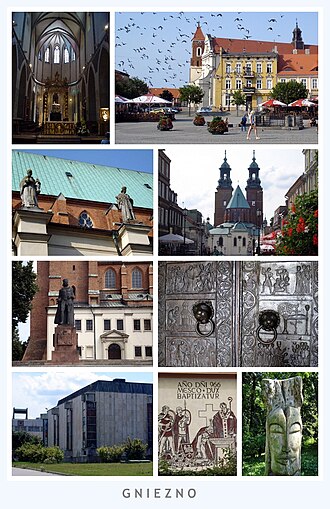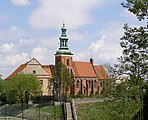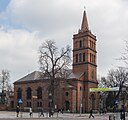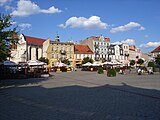Gniezno
| Gniezno | ||
|---|---|---|

|
|
|
| Basic data | ||
| State : | Poland | |
| Voivodeship : | Greater Poland | |
| Powiat : | Gniezno | |
| Area : | 40.9 km² | |
| Geographic location : | 52 ° 32 ′ N , 17 ° 36 ′ E | |
| Residents : | 68,323 (Jun. 30, 2019) |
|
| Postal code : | 62-200 to 62-210 | |
| Telephone code : | (+48) 61 | |
| License plate : | PGN | |
| Economy and Transport | ||
| Street : | Poznan - Bydgoszcz | |
| Rail route : | Poznan – Toruń | |
| Next international airport : | Poznań-Ławica | |
| Gmina | ||
| Gminatype: | Borough | |
| Residents: | 68,323 (Jun. 30, 2019) |
|
| Community number ( GUS ): | 3003011 | |
| Administration (as of 2014) | ||
| City President : | Tomasz Budasz | |
| Address: | ul.Lecha 6 62-200 Gniezno |
|
| Website : | gniezno.eu | |
Gniezno [ ˈgɲɛznɔ ] ( German Gnesen ) is a city in Poland , which belongs to the Greater Poland Voivodeship and is about 50 km east of Poznan . It is the seat of the Archdiocese of Gniezno .

|
history
Gniezno is one of the oldest cities in Poland; The first human settlements existed as early as the Stone Age . It was first mentioned in a document at the end of the 10th century, after the Christianization of Poland. The founder of the city is Duke Lech , who, according to legend, built his nest (Polish: gniazdo ) on the Lech hill like a white eagle in the treetop above him. The white eagle can be found both in the city's coat of arms and in the coat of arms of Poland .
The city has given its name to the Gniezno Glacier in Antarctica since 1980 .
Name of the city and founding legend
The name of the city Gniezno is derived from the Polish word gniazdo , which means nest in German . According to the legend about the creation of the Polish state, there were three brothers: Lech , the forefather of the Polish state, Czech ( Čech ), the forefather of the Czech state and Rus , the forefather of the Russian state. The brothers who originally lived together decided to go far. Czech settled south and Rus east. Lech decided to move north. When Lech came to what would later become Greater Poland, he rested in the shade of a tree. In the red of the evening he observed a magnificent white eagle that had landed on the crown of the tree above him. This event impressed Lech so much that he decided to settle here and found the town of Gniezno (Gnesen). From this point on, the white eagle is part of the city and Polish coat of arms, with the color red standing for the evening red.
middle Ages
There is evidence of a castle in Gniezno since the 8th century . From the 9th century it was the political center of the gradually emerging state of the Piasts . In the year 1000 there was the act of Gniezno . Bolesław I. Chrobry received Emperor Otto III here. , and the oldest Polish archbishopric was founded . In 1025 Bolesław I. Chrobry became the first king of Poland . In 1238/39 Gniezno received city rights . Until 1320 the city was the coronation site of the Polish kings.
Gniezno has long been the cultural center of Poland. Poland associates the beginnings of its state with this city.
Modern times
During the Second Partition of Poland in 1793, Gniezno became part of the Kingdom of Prussia . In 1807 it was added to the Duchy of Warsaw by Napoleon .
After the Congress of Vienna , Gnesen was part of the Gnesen district in the Prussian province of Posen , administrative district Bromberg .
During the (Europe-wide) famine of 1847 Gnesen was the scene of civil war-like unrest. Stores and shops were looted.
With the entry into force of the Versailles Treaty on January 20, 1920 Gnesen became part of the Republic of Poland and was an independent urban district from 1925.
After the invasion of Poland , Gnesen became part of the German military district of Posen on September 11, 1939, and incorporated into the German Reich on October 26, 1939 . From then on it belonged to the Reichsgau Posen , later Wartheland and the administrative district Hohensalza . As of January 1, 1940 Gniezno was under the in Altreich valid German Municipal Code of 30 January 1935 with a German mayor ( Julius Lorenzen (NSDAP)) at the top.
In January 1945 the city was occupied by the Red Army and came back to Poland after the end of the Second World War . The German residents fled or were expelled .
- Dziekanka
In the settlement of Dziekanka (German: Dean's Office , 1939–1945: Tiegenhof ), which today belongs to Gniezno , a psychiatric institution of the district was set up in 1894. The institution, which has been Polish since 1920, was renamed the Tiegenhof Gauheilanstalt in 1939 . The director Victor Ratka collaborated with the German occupiers and remained in office.
Initially, over 1200 Polish prison inmates were murdered in gas vans by the Lange Sonderkommando . After the end of the murders , from the end of 1941 prison inmates were transferred from the German Reich to Tiegenhof, where they were murdered by depriving them of food and giving lethal drug cocktails. In a trivializing way, one spoke of a “ children's department ”. The total number of those killed is put at 3586.
traffic
Gniezno is located on the Poznań – Toruń railway line and on the Oleśnica – Chojnice and Gniezno – Sława Wielkopolska railway lines, which are only used for freight transport near Gniezno . The city is the starting point of the Gnieźnieńska Kolej Wąskotorowa , the former Witkowo district railway.
Buildings
The Arch-Cathedral of Gniezno is one of the most important church buildings in Poland. The church has been the main church of the Archbishop of Gniezno and the Primate Poloniae (Primate of Poland) since the 15th century . The two-winged bronze door of Gniezno in the Arch-Cathedral is of European importance . On the occasion of Pope John Paul II's visit to Poland in 1997, the German artist Heinrich Gerhard Bücker created a new high altar for the Arch Cathedral , which was personally consecrated by the Pope during his visit.
The Gothic Rector Church of St. John the Baptist in Gniezno is a church building of the Order of the Knights of the Holy Sepulcher and houses wall paintings from the 14th century.
Other churches are: the Holy Trinity Church , the Church of the Holy Cross, the Peter and Paul Church, the Church of Archangel Michael, the Coronation Church of the Polish Kings and the Church of St. George. The former Protestant garrison church is now a Catholic place of worship under the patronage of Mary, Queen of Poland .
There are also a number of restored historical buildings and museums. The Archbishop's Archives in Gniezno display religious objects, including paintings, sculptures, vestments and coffin portraits. The didactic museum of the origins of the Polish state documents the early history of Gniezno and its time as the capital of the Polish nation.
Rural community
The rural community of Gniezno, to which the town of Gniezno does not belong, had 9,490 inhabitants in June 2010.
politics
City President
At the head of the city administration is the city president . Since 2014 this has been Tomasz Budasz PO . The regular election in October 2018 led to the following results:
- Tomasz Budasz ( Koalicja Obywatelska ) 79.3% of the vote
- Paweł Kamiński ( Prawo i Sprawiedliwość ) 16.3% of the vote
- Jerzy Lubbe (Election Committee of the Gniezno Local Voters' Association) 2.4% of the vote
- Zenon Miękiszak ( Kukiz'15 ) 2.0% of the vote
Budasz was thus re-elected for a further term in the first ballot.
City council
The city council has 23 members who are directly elected. The election in October 2018 led to the following result:
- Koalicja Obywatelska (KO) 62.5% of the vote, 17 seats
- Prawo i Sprawiedliwość (PiS) 21.5% of the vote, 5 seats
- Election Committee of the Gniezno Local Voters' Association 11.8% of the vote, 1 seat
- Kukiz'15 4.2% of the vote, no seat
Town twinning
- Anagni , (Italy)
- Esztergom , (Hungary)
- Falkenberg , (Sweden)
- Radviliškis , (Lithuania)
- Roskilde , (Denmark)
- Saint-Malo , (France)
- Sergiev Posad , (Russia)
- Speyer , (Germany, Rhineland-Palatinate)
- Uman , (Ukraine)
- Veendam , (Netherlands)
Sports
Soccer
The third division soccer team Mieszko Gniezno is based in Gniezno . Other football clubs from Gniezno are: KS Gniezno, Techmet Orliki Gniezno and Gniewko Gniezno.
Speedway
The speedway club TŻ Start Gniezno competes in the 1st Polish league. The team carries out their competitions in the Start Gniezno Stadium, which has a capacity of 10,000 spectators.
sons and daughters of the town
- Julian von Chelmicki (1825–1909), member of the Reichstag and Landtag
- Hermann Senator (1834–1911), successor to Rudolf Virchow as 1st chairman of the Berlin Medical Society , clinical director at the Berlin Charité and professor, author of important papers on kidney diseases and protein excretion
- Jacob Caro (1835–1904), historian, professor in Jena and Breslau, wrote studies on Polish, Russian, late medieval and early modern history.
- Werner Alberti (own Krzywonos) (1860–1934), opera singer (tenor)
- Otto Nollau (1862–1922), Lord Mayor of Remscheid
- Felix Waldstein (1865–1943), politician (DDP)
- Siegfried Laboschin (1868–1929), painter and graphic artist
- Georg Davidsohn (1872–1942), social democratic politician and journalist
- Arthur Hübner (1878–1934), psychiatrist, forensic doctor and university professor
- Kurt Jahnke (1882–1945), German-American secret agent
- Łucjan Kamieński (1885–1964), composer and musicologist
- Wilhelm Bahnik (1900–1938), communist resistance fighter
- Richard Honig (1890–1981), German criminal lawyer
- Wilhelm Storz (1897–1985), lawyer, holder of the Knight's Cross of the Royal House Order of Hohenzollern with Swords, author of the textbook "German Criminal Law" (3rd edition 1963)
- Günther Pancke (1899–1973), SS-Obergruppenführer
- Heinz Reinefarth (1903–1979), SS group leader , politician
- Edward Bury (1919–1995), composer, conductor, pianist and music teacher
- Mieczysław Porębski (1921–2012), art historian
- Hans-Jürgen Gerhardt (1928-2010), physician
- Johann-Christoph Student (* 1942), psychiatrist and palliative medicine specialist
- Paweł Arndt (* 1954), politician
- Krzysztof Wętkowski (* 1963), auxiliary bishop in Gniezno
- Arkadiusz Radomski (* 1977), football player
- Marika Popowicz (* 1988), Polish athlete
bibliography
Monographs, articles
- Heinrich Wuttke : City book of the country Posen. Codex diplomaticus: General history of the cities in the region of Poznan. Historical news from 149 individual cities . Leipzig 1864, pp. 311-316.
- Guide to Gniezno, its history and sights . Otto Pabst, Gnesen 1913 ( e-copy )
- Gniezno. Past and present . (= Series of publications of the city of Speyer; vol. 8). City administration, Speyer 1997.
- Wilfried Gerke , with the help of Elfriede Henke: Germans in Gnesener Land. Home book for the Gnesen-Witkowo district . Office of the home district community Gnesen, Hanover 1981.
- Ursula Mende: The bronze doors of the Middle Ages. 800-1200 . Hirmer, Munich 1983, ISBN 3-7774-3530-9 , p. 84 ff.
- Enno Schwanke: The Tiegenhof psychiatric institution. The National Socialist “ euthanasia ” from a regional perspective. Berlin 2013 (Master thesis FU Berlin ).
Web links
- City website (multilingual)
Individual evidence
- ↑ a b population. Size and Structure by Territorial Division. As of June 30, 2019. Główny Urząd Statystyczny (GUS) (PDF files; 0.99 MiB), accessed December 24, 2019 .
- ^ Jan Długosz: Lech, Czech i Rus ; P. 164.
- ^ Hans-Heinrich Bass: Hunger crises in Prussia during the first half of the 19th century. Scripta Mercaturae Verlag, St. Katharinen 1991, ISBN 3-922661-90-4 , p. 248.
- ^ Tiegenhof Children's Department , University of Vermont, accessed October 10, 2015
- ↑ Marian Drogowski: HISTORIA, Okres okupacji hitlerowskiej 09/11/1939-21/01/1945 (Polish, on the website of today's hospital) ( Memento of the original from August 14, 2015 in the Internet Archive ) Info: The archive link was automatically inserted and not yet checked. Please check the original and archive link according to the instructions and then remove this notice.
- ↑ The churches are taken from a city map posted at ul. Tumska.
- ↑ Główny Urząd Statystyczny, "LUDNOŚĆ - STAN I STRUKTURA W PRZEKROJU TERYTORIALNYM" ( Memento of May 15, 2011 in the Internet Archive ) as of June 30, 2010.
- ↑ Result on the website of the election commission, accessed on August 25, 2020.
- ↑ Result on the website of the election commission, accessed on August 25, 2020.







